There was a thread called 'Fake OPA627 in the wild' I can't find anymore, but I bought a pair of the OPA627BP an asian DIYer
showed there (something like 'W18....' printing) and measured
a resistance in the 40kOhm range between Pin1 and Pin5 (instead of the awaited 50kOhm range), so I think it's a OPA627AP for real.
It also sounds more like the A version (more slamming bass and more crispy highs).
showed there (something like 'W18....' printing) and measured
a resistance in the 40kOhm range between Pin1 and Pin5 (instead of the awaited 50kOhm range), so I think it's a OPA627AP for real.
It also sounds more like the A version (more slamming bass and more crispy highs).
No, that is not a good test to see if it's genuine. No opamp has exactly the same offset and offset drift, in that respect they're as unique as fingerprints.
When replacing an opamp in an already adjusted product, I find that offset is usually off by at least 0.10 mV.
A regular handheld DMM (which I'm assuming you used), will not be accurate enough to give you the actual value and might display 0.0 mV when it might be 0.1 or even 0.2 mV.
Look at the specs of your DMM, and it'll read x.x%, +x digits (percentage of reading + percentage of full scale - usually in counts). Even a good one, like Fluke 175, is 0.15%, + 2 digits in the 0-600 mV range. The resolution is 0.1 mV and that is too coarse to accurately display the actual value of such small offsets. Lets forget about cheap DMMs altogether.
A 6.5 digit bench DMM, like e.g. the Agilent 34401A, that is recalibrated anually is needed to measure these kinds of values accurately.
To give you an idea, this DMM has a accuracy in the 0-100.0000 mV range of 0.003% of reading + 0.003% of scale that will decrease to 0.005% rdg + 0.035% scale after a year, at which point it will need to be recalibrated (an ISO-requirement for a company like ours). The resolution in that range is 0.0001 mV.
In short: finding a replacement that has the exact same offset as the one it replaces is highly improbable, even though it may read like that on a regular DMM.
When replacing an opamp in an already adjusted product, I find that offset is usually off by at least 0.10 mV.
A regular handheld DMM (which I'm assuming you used), will not be accurate enough to give you the actual value and might display 0.0 mV when it might be 0.1 or even 0.2 mV.
Look at the specs of your DMM, and it'll read x.x%, +x digits (percentage of reading + percentage of full scale - usually in counts). Even a good one, like Fluke 175, is 0.15%, + 2 digits in the 0-600 mV range. The resolution is 0.1 mV and that is too coarse to accurately display the actual value of such small offsets. Lets forget about cheap DMMs altogether.
A 6.5 digit bench DMM, like e.g. the Agilent 34401A, that is recalibrated anually is needed to measure these kinds of values accurately.
To give you an idea, this DMM has a accuracy in the 0-100.0000 mV range of 0.003% of reading + 0.003% of scale that will decrease to 0.005% rdg + 0.035% scale after a year, at which point it will need to be recalibrated (an ISO-requirement for a company like ours). The resolution in that range is 0.0001 mV.
In short: finding a replacement that has the exact same offset as the one it replaces is highly improbable, even though it may read like that on a regular DMM.
Last edited:
No, that is not a good test to see if it's genuine. No opamp has exactly the same offset and offset drift, in that respect they're as unique as fingerprints.
When replacing an opamp in an already adjusted product, I find that offset is usually off by at least 0.10 mV.
A regular handheld DMM (which I'm assuming you used), will not be accurate enough to give you the actual value and might display 0.0 mV when it might be 0.1 or even 0.2 mV.
Look at the specs of your DMM, and it'll read x.x%, +x digits (percentage of reading + percentage of full scale - usually in counts). Even a good one, like Fluke 175, is 0.15%, + 2 digits in the 0-600 mV range. The resolution is 0.1 mV and that is too coarse to accurately display the actual value of such small offsets. Lets forget about cheap DMMs altogether.
A 6.5 digit bench DMM, like e.g. the Agilent 34401A, that is recalibrated anually is needed to measure these kinds of values accurately.
To give you an idea, this DMM has a accuracy in the 0-100.0000 mV range of 0.003% of reading + 0.003% of scale that will decrease to 0.005% rdg + 0.035% scale after a year, at which point it will need to be recalibrated (an ISO-requirement for a company like ours). The resolution in that range is 0.0001 mV.
In short: finding a replacement that has the exact same offset as the one it replaces is highly improbable, even though it may read like that on a regular DMM.
@jitter: Thanks for your detailled info! Do you think/know if replacing an OPA627 in an adjusted device and measuring the offset can at least show that it's really an OPA627 (A or B) and not a fake chip (with a difference greater than, say, a few millivolt) ?
No, I don't think so. Other opamps may have comparable offset voltages.
Without readjusting ?
LM353 is one of the few OPs with the same offset pins
(others often need negative offset supply instead positive),
but it's offset has to be hugely readjusted when replacing OPA627 with it.
That's right, unless there's something really out of the ordinary, the change in offset is no measure for genuineness. Some opamps may not differ from the '627 that much when it comes to offset adjustment.
The designs I know with the OPA627 indeed use positive rail for offset adjustment. But lets not forget that most audio designs do not use offset adjustment at all.
The designs I know with the OPA627 indeed use positive rail for offset adjustment. But lets not forget that most audio designs do not use offset adjustment at all.
Last edited:
@jitter: You argue, that newly produced OPs are alread trimmed for zero offset, right ?
No, that's not what I meant. Obviously the production process aims for a low offset, but it's never going to be exactly 0. Add to that the fact that the offset will drift with change in temperature (small, but it's there).
Each and every opamp has its own unique offset. At work, I often have to swap one opamp for another and find that the new one always needs readjusting the offset, and every time it's different by how much.
could anyone help in identifying this particular chip as being authentic or not? i purchased this a few months back on ebay being advertised as vintage opa627ap's from a 1992 batch i think he removed from an old reciever or something
You can always check the seller's auctions for more of these chips. If he's selling more of them, chances are there's smth else going on...
could anyone help in identifying this particular chip as being authentic or not? i purchased this a few months back on ebay being advertised as vintage opa627ap's from a 1992 batch i think he removed from an old reciever or something
First of all, I would suspect any offering of the OPA627 on eBay, so I'd assume them to be fake until proven otherwise.
Second, I never dealt with 20 year old OPA627s, so I have nothing for comparison. Keep in mind that counterfeiters may copy datcodes of genuine products.
Remove the ICs from the socket and look at the leads. If they were indeed salvaged from an old receiver, they likely have remains of solder on them.
I would advize you construct the circuit of posts #23/24 and measure the quiescent current. If it's not 7-7.5 mA, it's not an OPA627.
Last edited:
You can always check the seller's auctions for more of these chips. If he's selling more of them, chances are there's smth else going on...
I never saw filled triangle on BB ICs
do these OPA627 look like fakes?
It's quite easy to know if they are fakes or not. Check the farnell or mouser website. If the part's price (new) is below the price for the Opamp on farnell (> 1000 pieces) than it is a fake!
Regards,
Andy
something odd
Okay, time to bump up this thread.
Ever since I started this thread, the usage of the OPA627BP at work has continued unchanged. We're talking about a 1,000 of these a year.
These are always acquired through authorized channels.
What strikes me is that the datecode on the OPA627BP doesn't seem to progress anymore.
It´s as if in 2011 TI/BB produced some very large batches or as if our supplier(s) stocked up large amounts. As far as I know, we keep buying them in batches and don't stock them up ourselves.
They are from different lots, but the datecode parts have yet to go past June 2011.
The datasheet was last updated November 2014 and the status of this version is still "active".
I don't know if this means anything, but I thought I'd share this IMO remarkable fact and wonder if anyone out here has seen the same thing when bought from authorized dealers...
Okay, time to bump up this thread.
Ever since I started this thread, the usage of the OPA627BP at work has continued unchanged. We're talking about a 1,000 of these a year.
These are always acquired through authorized channels.
What strikes me is that the datecode on the OPA627BP doesn't seem to progress anymore.
It´s as if in 2011 TI/BB produced some very large batches or as if our supplier(s) stocked up large amounts. As far as I know, we keep buying them in batches and don't stock them up ourselves.
They are from different lots, but the datecode parts have yet to go past June 2011.
The datasheet was last updated November 2014 and the status of this version is still "active".
I don't know if this means anything, but I thought I'd share this IMO remarkable fact and wonder if anyone out here has seen the same thing when bought from authorized dealers...
Last edited:
As a result of a PM from a fellow diyAudio member on the OPA627, I decided to add a few more measurements on a genuine OPA627AP.
I already posted the results of comparative measurements in this post, just over four years ago. But now that the test equipment I have available at home is a bit more sophisticated, I can post better images of the results.
I chose to do similar measurements as back then with the OPA627 setup as voltage follower (buffer), no load on the output. The circuit was fed with +/- 15 V from a linear lab PSU.
One set of measurements was taken at 100 kHz, 5 Vpp and another at 500 mVpp. First a couple of waveforms and then zoomed in on the rising and falling slopes.
Channel 1 (yellow) shows the signal right at the input pin of the opamp, CH3 (pink) the output.
The setup on a breadboard was not ideal (hence some ringing) but good enough for comparison with other opamps. The OPA627 can follow the input really well, though with larger signals it doesn't have as good a response as with smaller signals (as expected).
If a suspected-to-be-fake OPA627 doesn't do this equally well, then it most likely is indeed a fake.
I already posted the results of comparative measurements in this post, just over four years ago. But now that the test equipment I have available at home is a bit more sophisticated, I can post better images of the results.
I chose to do similar measurements as back then with the OPA627 setup as voltage follower (buffer), no load on the output. The circuit was fed with +/- 15 V from a linear lab PSU.
One set of measurements was taken at 100 kHz, 5 Vpp and another at 500 mVpp. First a couple of waveforms and then zoomed in on the rising and falling slopes.
Channel 1 (yellow) shows the signal right at the input pin of the opamp, CH3 (pink) the output.
The setup on a breadboard was not ideal (hence some ringing) but good enough for comparison with other opamps. The OPA627 can follow the input really well, though with larger signals it doesn't have as good a response as with smaller signals (as expected).
If a suspected-to-be-fake OPA627 doesn't do this equally well, then it most likely is indeed a fake.
Attachments
-
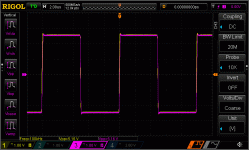 OPA627AP LSR 100 kHz 5 Vpp.gif27.9 KB · Views: 325
OPA627AP LSR 100 kHz 5 Vpp.gif27.9 KB · Views: 325 -
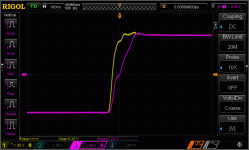 OPA627AP LSR 100 kHz 5 Vpp RE.gif28.8 KB · Views: 322
OPA627AP LSR 100 kHz 5 Vpp RE.gif28.8 KB · Views: 322 -
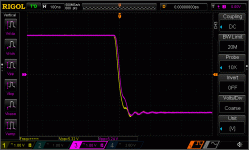 OPA627AP LSR 100 kHz 5 Vpp FE.gif27.7 KB · Views: 316
OPA627AP LSR 100 kHz 5 Vpp FE.gif27.7 KB · Views: 316 -
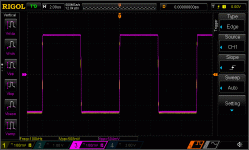 OPA627AP SSR 100 kHz 500 mVpp.gif27.1 KB · Views: 310
OPA627AP SSR 100 kHz 500 mVpp.gif27.1 KB · Views: 310 -
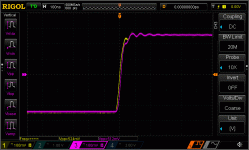 OPA627AP SSR 100 kHz 500 mVpp RE.gif29.4 KB · Views: 90
OPA627AP SSR 100 kHz 500 mVpp RE.gif29.4 KB · Views: 90 -
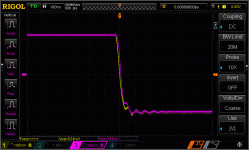 OPA627AP SSR 100 kHz 500 mVpp FE.gif30 KB · Views: 85
OPA627AP SSR 100 kHz 500 mVpp FE.gif30 KB · Views: 85
- Status
- This old topic is closed. If you want to reopen this topic, contact a moderator using the "Report Post" button.
- Home
- Design & Build
- Parts
- genuine OPA627 info
